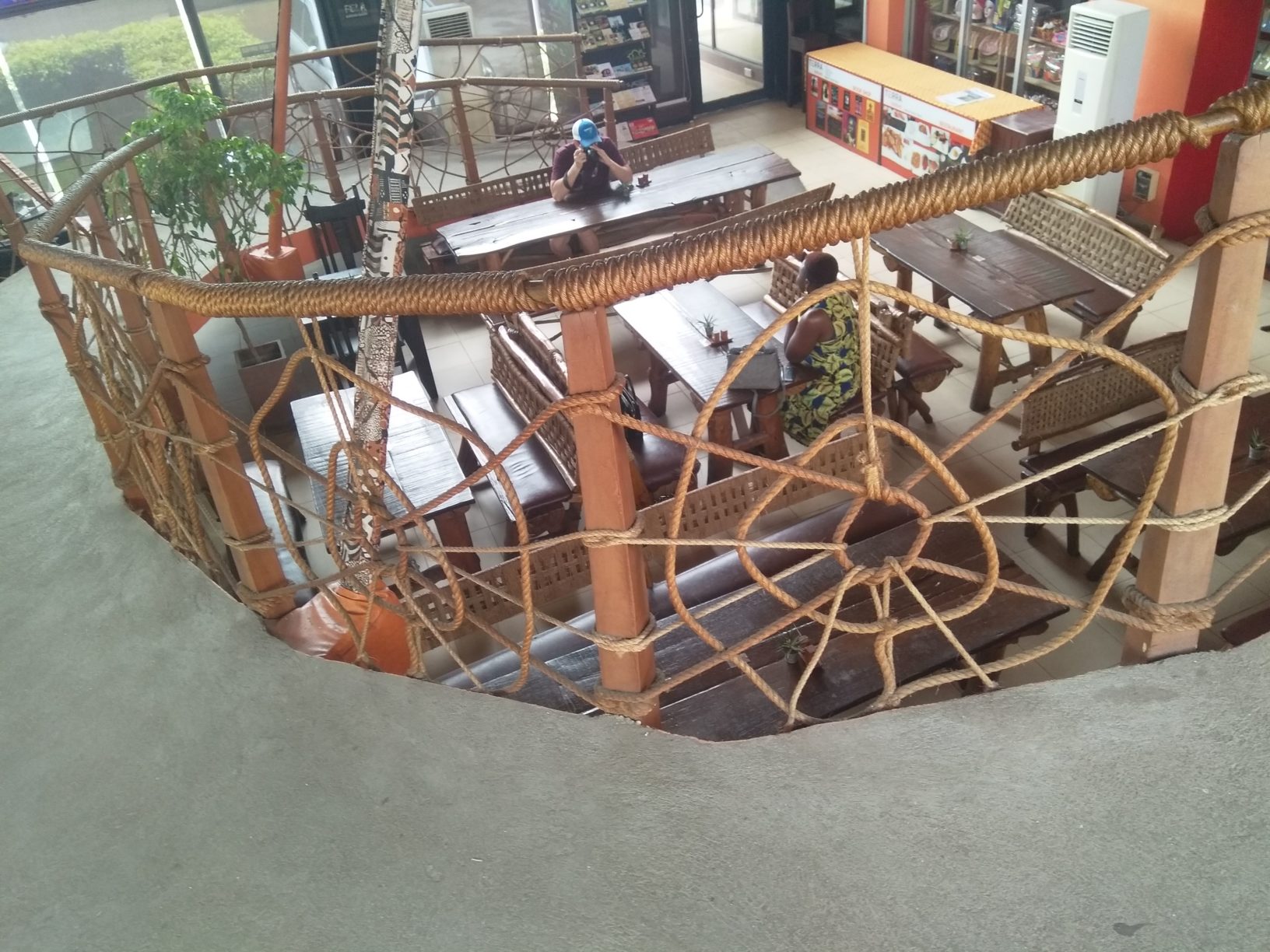I moved to Lagos in 2012, after studying and teaching in the United States for three years. Before then, I had spent my adult life in Ìbàdàn, a laid back city 120 kilometres northeast of Lagos. Settling on Lagos was a compromise: I did not want to return to my home city, because it was suffused with childhood memory, but I was suspicious of Lagos, because it had been branded “chaotic.” My own experience with the city as an occasional visitor never alleviated the fear that I could never get used to the speed, the noise, and the energy. I chose adventure over nostalgia.
Also, my years in the U.S. had trained me to enjoy adventure. I spent a large part of my postgraduate stipend traveling around the Midwest: as long as I had money, I would wake up, get in the car, and drive wherever I wanted, relishing the novelty of unfamiliar spaces. I documented these experiences on a travel blog, and later in a collection of travel poetry.

These unplanned trips around the U.S. contrasted to how I had lived in Nigeria. There, I had resisted travel, worried by the state of the roads and unsure of my welcome from fellow Nigerians. I had not traveled by myself out of the country’s western region where I’d had most of my education.
When I returned home briefly in May 2010, I saw my own country with new eyes. One day in Ìbadàn, without planning, I got up, picked up a traveling bag, and got on a bus first to Ifẹ̀. The next day, I was in Àkùngbá, and later Ìlọrin, Kaduna, Zaria, Lafia, Jos, and Abuja, meeting new people, bunking with friends, and seeing parts of the country that I would otherwise not have ventured towards.

After a few weeks, I returned to Lagos, having defied the fears and my earlier resistance. Whether in the backseat of a taxi driving through the winding roads between black imposing hills on the way to Obi in Nasarawa state, or on a motorbike cascading through the Friday crowd on their way back from the mosque in Zaria, or staring at the imposing minimalist architecture of the St. Bartholomew Church in Wusasa, my appreciation for unplanned journeys got a happy jolt.
From the U.S. it was easy to imagine I could craft a life as a travel guide in Lagos. In my spare time, I would take visitors around my adopted city, encountering it anew through their experiences. But when I returned to Lagos in 2012, this time to start a family, the responsibility of making a living through more conventional means put paid to the fantasy of a life in search of milking history and adventure through the open streets that welcomed with both open arms and wary eyes.
Still, when in the middle of August 2018, a friend tagged me in a Facebook post by Brandon Stanton where he asked for applications by interested people willing to help show him around during his upcoming trip to Lagos, I thought that he was looking for me.
I was familiar with Humans of New York and its famous founder who walked around cities asking people questions about their lives, which he then turned into readable captions under their photographs. I had heard some criticisms of the work, and I’d seen some of its successes. But most of all, I was impressed by its consistency: since 2010, Stanton had put out story after story of different shades of humanity from across the world. Travel writer to another, I wanted to meet him, and discover my new city through a foreigner’s eyes as others would have experienced me many years earlier in Edwardsville.
His post had asked for someone who knew the language of the environment, along with experience in travel and journalism. I knew he was looking for me.
“I’m a scholar, travel writer, and linguist,” I wrote in my quickly composed three-line email to apply for the role, with a link to my Wikipedia page. When I didn’t hear back after twelve minutes, I sent a follow up email, a one-liner that mentioned that I was also involved in helping fellow American Anthony Bourdain find his way around when he came to shoot Parts Unknown in April 2017. I got a response shortly afterwards. I had got the job.
Stanton and I kept in touch via WhatsApp over the coming weeks, and as he toured Cairo, the first African city he visited on this three-city trip. He was there for a week before landing in Lagos. I wanted to know what types of places he wanted to visit, what kinds of people he wanted to meet or not meet, and whether he needed any special assistance; and he wanted to know that I was familiar with his work, was capable of helping him achieve his goals, and could provide some clarity about some of his questions, top of which was whether it was important to go to Abuja at all, as he had also planned, or whether he would find the local English accent intelligible without a translator leaning in on every conversation. “You see, I get a lot more done when the conversation doesn’t have to go through a filter,” he said.
Work started on the same evening after I picked him up at the airport. “You’re taller than I had assumed,” he said, as we shook hands. “So are you,” I replied.
I had assumed that he travelled with an entourage, a team, or at least security. It was just us: two travellers from different environments about to take on an adventure. He had never visited Nigeria before, so there was always a chance that his outlook on the country would be coloured by American news portrayals, which might bleed into his work either as an activist intention to “show a different side” or a stereotypical pursuit of red-meat visuals for the Western gaze. I wondered if my presence would make any difference and whether my own biases about potential locations and subjects would affect the overall product.
Foreign documentarians of Lagos risk replicating stereotypes of Nigerians. The 2010 BBC2 documentary, Welcome To Lagos, which followed the lives of some slum-dwellers was widely panned online and by its Nigerian audience as voyeuristic and patronizing. Even Bourdain’s Parts Unknown was criticized for allegedly overlooking an ethnic population—the Igbo—whose entrepreneurial mark in Lagos is incontrovertible. My beef with Bourdain—other than the fact that his advance team had spent time talking to myself, a Nigerian food writer, and another friend for a scene in the shoot, and then ghosted us when they landed—was that they didn’t illustrate a part of Lagos I thought was important: the Aguda, descendants of the emancipados who had returned from Brazil and Cuba in the middle of the 19th Century and made a part of Lagos Island their home.
Yet, because Stanton’s work depends on encountering and engaging strangers, nothing could be pre-arranged or guaranteed. Before he arrived, I had talked with several people more familiar with Lagos than me, asking what areas would contain representative Lagosians but would also be calm enough to work. My list included the stadium at Surùlérè, Freedom Park at Lagos Island, at least one beach area in Lagos, a secondary school, Balógun Market, Conservation Center in Lekki, Ìwàyà near Yaba, the mall and Computer Village in Ìkẹjà.
 Kọ́lá Túbọ̀sún
Kọ́lá Túbọ̀súnBut after he had checked in to his room at Federal Palace Hotel and rested for a few minutes, Stanton was already interested in hitting the streets. It was late afternoon, so the Lagos Mainland was out. I suggested the Lekki Conservation Center, a nature preserve about twenty-five minutes away halfway to Ẹ̀pẹ́ It was the nearest, easiest place to find people in a relaxed environment, surrounded by nature, and with nowhere to go. It was a good entry into the busy city, but heading there at around four o’clock was a risk, since it closed at five, and we weren’t sure what traffic was like.
But we made it. Our first subject was a young woman who sat under a shed near the reception area—she appeared bored and resigned. The Center was nearing closing time, and she likely had gone on the nature walk and was just waiting to be picked up on her way home. She was staring at her phone. “Do you think she’d be interesting?” I asked Stanton. “Go for it,” he said.
I approached her. After a quick introduction, I mentioned that my friend, the foreigner, had come from New York and was interested in speaking to, and photographing, strangers for his art project. Stanton, now nearby, took over with a short introduction he’d probably recited a million times.
“Hi. I am an artist. I have an instagram page, where I post photos of people I talk to all over the world. I have over 30 million followers, and I would love to talk to you if you don’t mind, and ask a few questions.”
“Sure,” she said, and I slid away nearby to keep an eye on them.
“Occasionally, especially when I’m out of the US,” Stanton had told me earlier, “people intrude on the conversation because they have seen a foreigner with a camera, and want to be a part of it. It will help if you’re able to prevent that.” I played guide and guard.
In about fifteen minutes, interrupted by him occasionally getting up to take her photos while gesturing to her to continue talking, they were done. While she was initially suspicious when we approached her, by the time he was done, she had warmed up and was cheerful. He gave her the link to his instagram page and she volunteered even more information about her work.
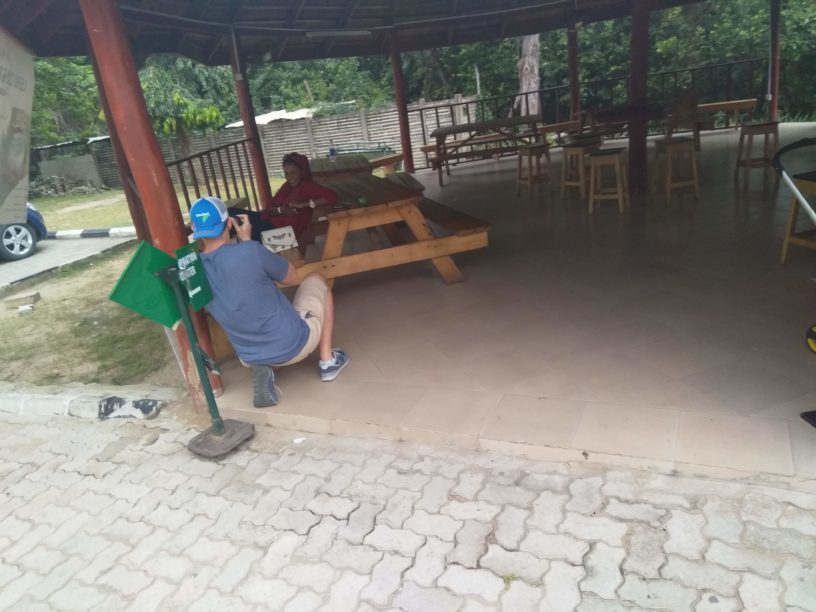 Kọ́lá Túbọ̀sún
Kọ́lá Túbọ̀sún“How did it go, for a first subject?” I asked when Stanton came back to me. “It was nice. She was quite friendly,” he said.
I’d been to the Conservation Center more than a dozen times, sometimes on my own, and sometimes with visiting guests. Its unique experience of greenery and nature in the middle of noise and auto pollution was always a welcome calm to the mind. And though the quality of the forest had reduced over time due to poor management and lack of funding, it retained a lot of its magic.
At five-thirty, those who had gone on the nature walk had returned and were being shown out. We had paid for a walk, just to gain access to the premises, but we hadn’t got any value for our money so I suggested we walk a few meters so I could show my guest a bit about the compound.
“Hello sirs,” a voice called us back just as we had stepped into the planks heading into the forest. “We are closed. You can’t go in now.” I asked Stanton to keep walking. The young man who had called ran and caught up with us. “I’m sorry sirs. It’s too late for a walk today.” “Oh no,” I responded. “I am not intending to go all the way. I just wanted to show him a bit of the property. We’ll be back in a second.”
He looked tentative, but let us go. And, as promised, we came back to the reception area in a few minutes.
“Would you like to talk to the young man?” I asked Stanton just as we were about to head out. “We still have some time before nightfall after all.” “Well, sure,” he replied. I walked back towards the reception and approached the young man. He didn’t know what we were up to but welcomed a chance to talk to “my New York friend.” They went away to a quiet part of the park, while I waited. In about twenty minutes, it was over and we headed out.
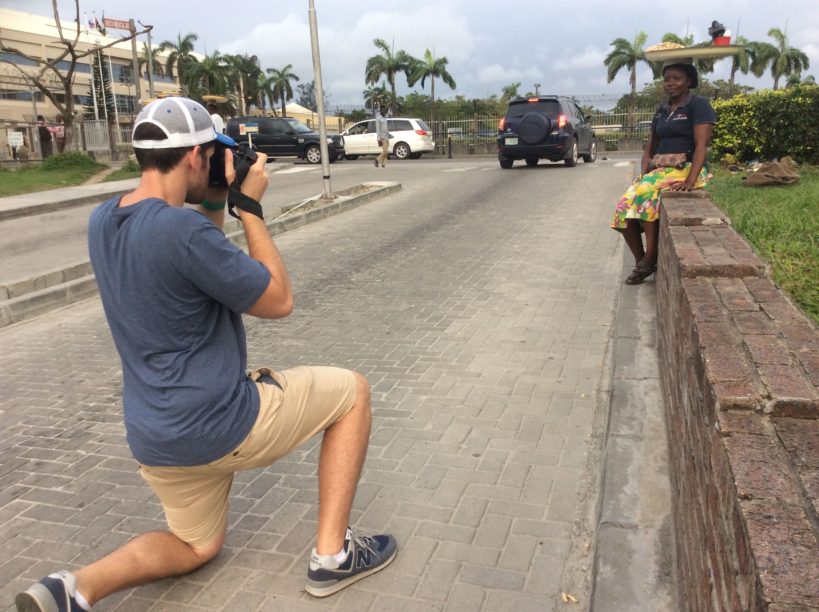 Kọ́lá Túbọ̀sún
Kọ́lá Túbọ̀súnA few minutes later, at Chevron Drive, Stanton nodded towards a middle-aged woman selling groundnuts. “Do you think we might be able to talk to her?” It was an open street near a gated estate with private cars driving by. I beckoned at her to buy her wares even if I wasn’t hungry. Stanton took over when he saw an opening.
Unlike the relatively private space of the Conservation Center, where Stanton could chat with subjects and photograph them without attracting much attention, this roadside session between a white foreigner and a groundnut seller was monitored by passer-bys, other groundnut sellers in the area, and the young private security men nearby who, however, had the good sense to stay away.
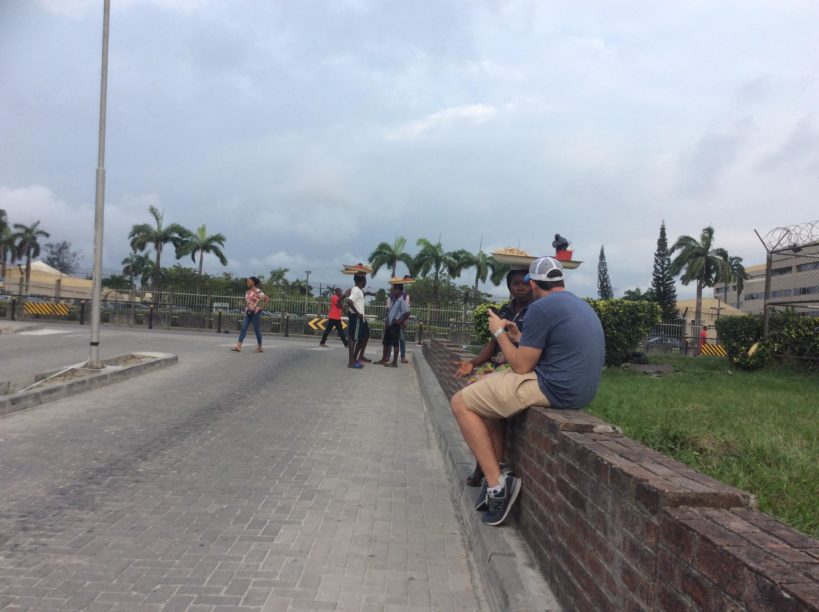 Kọ́lá Túbọ̀sún
Kọ́lá Túbọ̀súnBy the end of the first day, Stanton had interviewed about four people.
At Tiamiyu Savage the next morning, we approached a middle-aged man reading a newspaper by himself. He was an easy target. Two earlier subjects we had approached earlier on the street had either sped up, suspicious of our interest, or didn’t have the patience to make sense of what Stanton was saying. The man, who seemed to take in the deliberate slowness of the day from the vantage point of a concrete slab facing out onto the busy street, welcomed the chance to have his photo taken by a stranger.
At Terra Kulture, we spoke with two people — first, a young woman who had opened up on a rape story with a close family relation, and her cousin who had to wait with me while the former talked in the privacy of the open restaurant with Stanton.
“It was a moving story,” Stanton told me later. “I’m surprised she wanted me to take a photo of her face to go with it. I took one of her back as well, just to be sure. You never know with these things. I have had people call after the story is published asking that it be removed because they never expected it to get that kind of attention.”
This would prove prescient when the entry was eventually published, for a few minutes, and then deleted. The lady had apparently tried to reach Stanton over the three weeks between the encounter and the publication of the story. Not knowing how, she sent countless direct messages on Instagram which got lost among the hundreds that Stanton gets every day. After the story was published, with her face as she had originally requested, she sent a few more direct messages requesting that the shot of her back be used instead. Stanton merely pulled down the entry.
“Much better that way,” he told me. “Posting it again, even with a different photo, would have opened me up to needless questions. But I feel very bad about this. She seemed pretty certain when the photo was taken, in spite of my entreaties to the contrary.”
Stanton does not identify as a journalist.
In a post on Patreon many months after he had left Nigeria, he expounded on that decision. “Whenever I’m filling out an application for a travel visa,” the post began “there’s always a section entitled ‘Purpose of Visit.’ I must check one box: business, tourism, or journalism. I always choose tourism because it causes the least amount of headaches. A journalist visa requires extra scrutiny, and I don’t want to run the risk of getting rejected, especially in countries that are suspicious of Western journalists. But declaring myself as a tourist can also put me in an awkward situation. I’m a lone American walking around with a camera and interpreter, conducting extensive interviews with people on the street. At any moment I can be approached by security forces, who might ask the magic question: ‘Is this journalism?’”
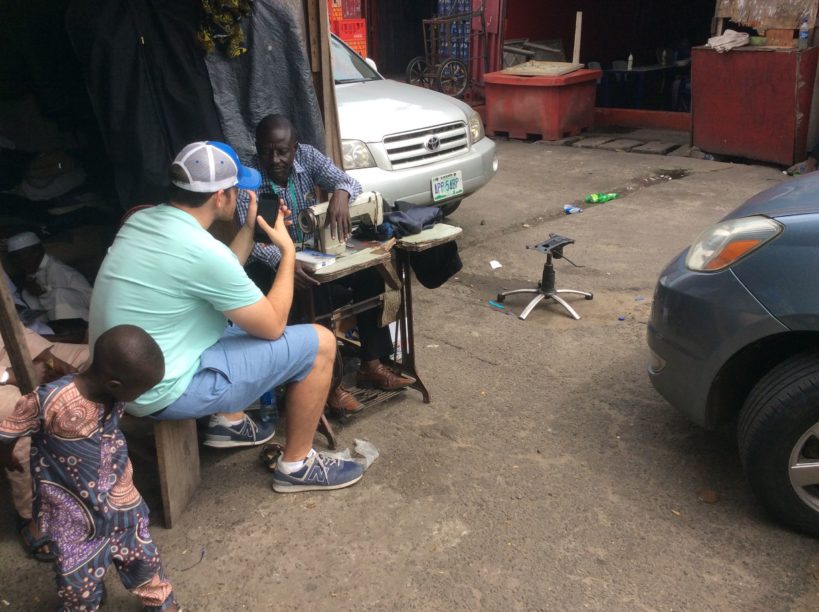 Kọ́lá Túbọ̀sún
Kọ́lá Túbọ̀súnAt CMS, on another day, near a local buka, we couched on a wooden bench and spoke with a tailor named Awwal who had three sons, and whose childhood dream, before his parents passed, was to attend Oxford University. After a few minutes, we had attracted attention and some area boys approached.
Their leader, a scruffy young man of around thirty five, said, “You can’t just come here with òyìnbó, and take pictures, and not pay the boys.” “But you’ll have to let him finish first,” I said calmly, with a posture that showed I would not let him near the conversation happening behind me.
I beckoned to some other men on the other side who had helped us park my car a few minutes earlier. They were “good” area boys in charge of the buka vicinity. Their turf was being intruded on and I thought they had a role to play. It worked. Three of them came and dislodged the troublemakers.
But attention had now been directed at us and followed us around that space—it made our work more difficult, and we had to leave earlier than we had planned, after “settling” the good area boys for their work as well.
 Kọ́lá Túbọ̀sún
Kọ́lá Túbọ̀súnAt a coffee shop at Ozone in Yaba, where we had come for a short break, a young lady caught Stanton’s attention. And though the plan was to get cups of coffee and return to the Island, he insisted on talking to her. I obliged and read a book. While they talked, another young man in the space who had, perhaps, eavesdropped on the conversation, came to sit by me. “Is that Brandon Stanton of Humans of New York?” Half an hour later, I’d introduced him to Stanton, and he had been interviewed and photographed.
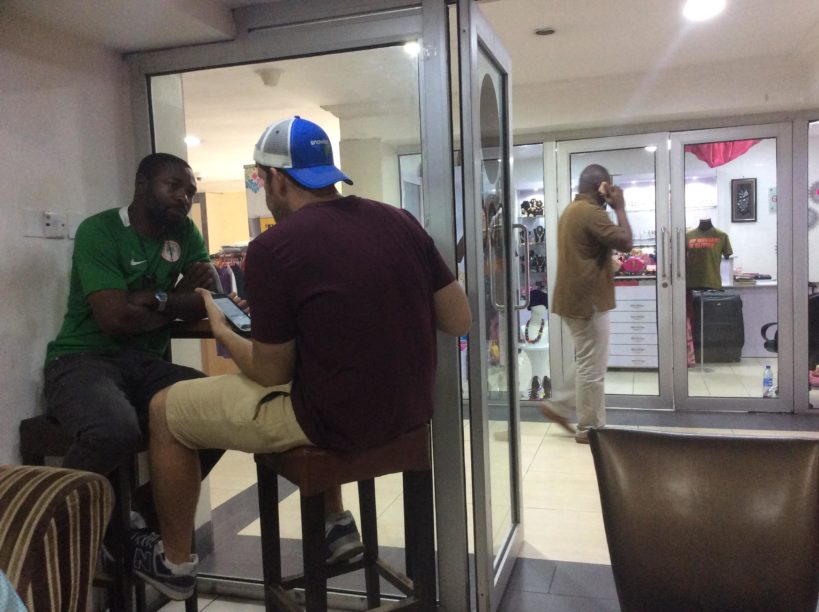 Kọ́lá Túbọ̀sún
Kọ́lá Túbọ̀sún“Talking to him got me thinking,” Stanton told me afterwards. “I would like to talk to some young startup founders. Do you know any?” Earlier in the day, I’d sent a text to the founder of Paystack, a rising startup in Lagos. I’d got the connection through my wife. He was not available to meet immediately, but would be ready in the evening.
“I will also want one led by women,” he added.
“Oh,” I thought, as an idea I’d tried to repress throughout the week came back to my mind. “I know one startup you might like.”
“Tell me about it,” he said, taking a gulp from the coffee paper cup.
“Well, there’s this young woman who grew up in Minnesota and came back to Nigeria in 2012 to start a health logistics company to solve the problem of blood shortage in Nigeria’s hospitals. It’s getting some good reviews. Even Mark Zuckerberg met with her while he was around.”
“I certainly would like to talk to her.”
“Okay good then,” I said, “cos she’s my wife.”
He burst out laughing.
“Yes, let’s do it,” he said.
“You sure?” I asked.
“Yes, of course,” he said, still laughing. “You’re smooth. I like that.”
I hadn’t planned to be, being very conscious of any appearance of favouritism, but it was too late now.
One evening after he had ventured out alone to Freedom Park by himself to get to know the city without the constraint of his guide, he had encountered an instance of police brutality on the street and he wanted to know more.
“Kọ́lá,” he wrote to me late in the night as I was heading out on a date. “How often does police brutality happen in Lagos?”
“More often than I can tell you. What happened?”
“I just witnessed something real disturbing. This driver was beaten within an inch of his life by uniformed policemen. In open air.”
He asked if I knew anyone else who had been a victim. He had interviewed his Uber driver who had experienced it with him, but he wanted another one. I remembered a Nigerian artist, who had once tweeted about being victimized for being a woman driving a fancy car, and had to sue the police to get justice. I contacted her on twitter, she sent me her phone number, and I arranged a meeting for the next morning.
On the same evening when he encountered the police battery, Stanton had heard another story of a young gala seller who had risked his life and bottomline by running after a van containing prisoners, and handing them individual gala snacks while they stretched their hands out of the van. The story had been told earnestly by a radio host whom Stanton now also wanted to meet. We sent the radio host countless messages through his twitter handle but he didn’t respond.
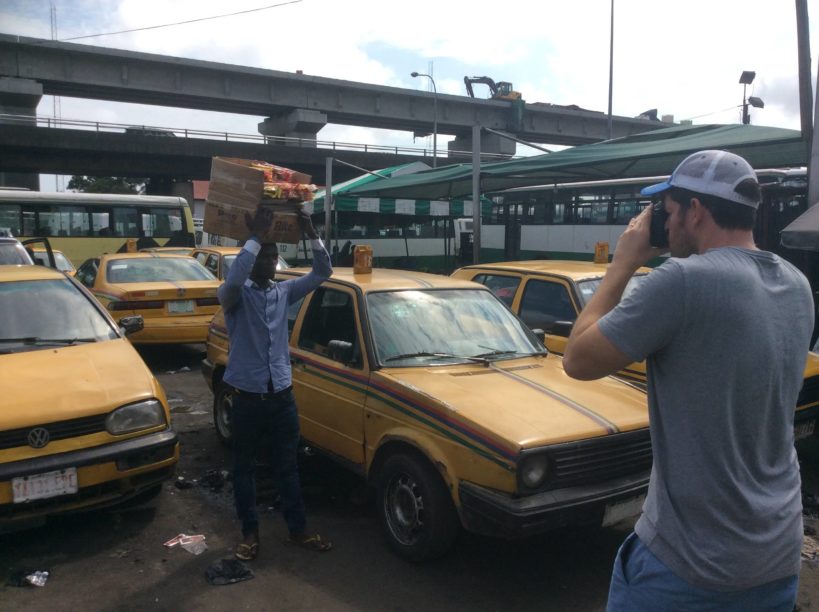 Kọ́lá Túbọ̀sún
Kọ́lá Túbọ̀súnWe spent a whole Saturday tracking down the gala seller—Ibere Ugochukwu. We heard his story and re-creating relevant photo shots at the motor park at CMS where he had plied his trade until his story made him famous. The earlier area boys returned when they heard that we had showed up in their space again, this time without our earlier saviours. We rebuffed them a second time through silence and bravado.
Spending about eight hours on the road each day wore us out. Stanton, whose body wasn’t used to the Nigerian environment, or mosquitoes, had begun to get symptoms of malaria. He was admitted into the hospital in Ghana a week after he left Nigeria.
During the week I guided Stanton, I learnt a few things about the process of making a HONY story: Stanton never recorded his subject’s voice. He typed their stories out longhand on his iPhone phablet with admirable speed. He revised them later, rearranging sentences to make the story readable and in HONY’s signature byte-sized curtness.
At Ìwàyà, I participated as a “translator” when the Nigerian English of the subject became too colloquial for Stanton to understand. Other times, I was the buffer between the recording of a riveting story and an angry mob intent on sabotaging it.
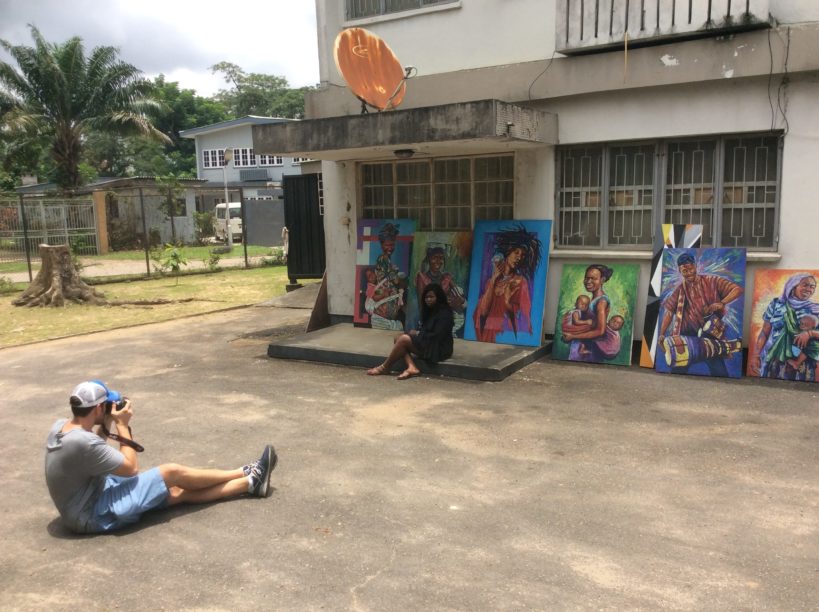 Kọ́lá Túbọ̀sún
Kọ́lá Túbọ̀súnAt a stop in Lekki, we walked into an art gallery and noticed a sweeper. We walked to the lady to ask for a little of her time. She and Brandon found a place to sit by the entrance, and I went in. In about twenty minutes, he had got a story, but was now also more interested in her life. Mary, who had obtained the needed five credits in the West African Examinations Council (WAEC) national exam, started this job because her previous occupation, working as a housekeeper in a pastor’s house, had ended when the man of god insisted on sleeping with her. She refused and fled. Her dream was to go to a Nigerian university for advanced studies.
But we had, for the twenty minutes, prevented her from doing the work for which she was employed. A group of young men called her away into a glass enclosure from where we heard them raise their voices. I tried to intervene to explain the purpose of our contact, but they wouldn’t entertain it. I wanted to be sure that her job was not threatened, and one of them dismissively assured me. Still, there was a tense feeling in the way he said it, so I promised to return a couple of weeks later.
After Stanton had returned to New York, we heard that Mary had been fired from the gallery. I returned to the gallery to attempt a mediation and failed. The co-owner, a grumpy retiree who sat by the entrance and was likely there when we came over the last time, ranted about how foreigners often come and trample over us in our own country. “They think they’re racist. I’m racist too!” he said, barely giving me a chance to talk. “I’m a retired security officer, you know,” he continued. “And you should be ashamed of yourself for bringing that man here. I could have got you arrested! I can get you arrested now!”
In late 2018, Stanton opened a Patreon account currently with 21,785 patrons who give at least $1.50 every month to help sustain the work. Across all social media, Humans of New York currently has over twenty-six million followers and counting. Through these funds, he committed to supporting a number of the subjects he profiled in Nigeria — like Mary, whom he promised to support through her university education if she passed her exams.
Many of the people Stanton met and supported through HONY donations called me many times over the following months, some to thank me for the encounter, many to ask for Stanton’s contact, ostensibly so they could thank him themselves, some to ask for even more help—even as small as a follow-back on Instagram—and, in some cases, to tell me the new positive developments in their lives.
I have not heard much from Ibere who had started to get famous before his story was featured on HONY, but who had then become even world-famous afterwards, with hundreds of people asking for his account number and sending him monies privately. The last time we chatted, he was asking me if I knew the process of leaving Nigeria. “I have seen that my people here will not allow me to focus on my career so I wish to give them some space,” he said.

